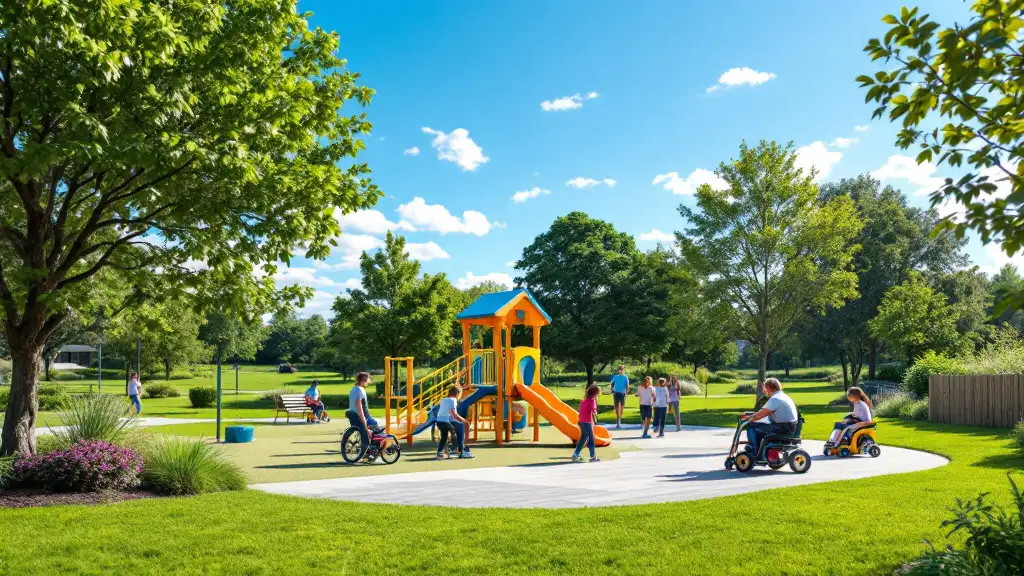
Facilitating Successful Transitions from Institutional to Community Living
The Division of Developmental Disabilities (DDD) plays a crucial role in shifting individuals with intellectual and developmental disabilities from institutional care settings to supportive community environments. This article explores the comprehensive strategies, policies, programs, and frameworks employed by DDD to promote deinstitutionalization, ensure person-centered care, and foster community integration. Through coordinated efforts like care management, supportive services, and adherence to federal regulations such as the HCBS Settings Rule, DDD strives to enable individuals to live independently and actively participate in their communities.
Care Management and Transition Procedures

How do support mechanisms and services facilitate the transition from institutional care?
Support systems play an essential role in helping individuals move from institutions to community living. Personalized service plans, which remain in effect for at least 90 days, are developed before discharge to address each person’s unique needs. These plans include efforts to provide housing, behavioral health therapies, employment opportunities, and day supports. Funding through Medicaid Home and Community-Based Services (HCBS) programs covers many of these supports, ensuring individuals receive the necessary services.
Transition assistance also involves community services like peer mentorship, supported employment, and residential options tailored for independence. During the initial transition, a Division Case Manager oversees activities, working closely with support coordinators to assure continuous care. After the first 60 days, the Support Coordinator takes primary responsibility, maintaining oversight during the critical adjustment period.
Resources like home modifications and community integration opportunities are vital. These help individuals adapt successfully to home environments, fostering independence and reducing the risk of re-institutionalization.
What is the role of policies in supporting community reintegration?
Government policies underpin the entire process by setting standards and providing funding streams. Programs such as Medicaid waivers, the HCBS Settings Rule, and the Money Follows the Person initiative create a supportive legal and financial environment. These policies incentivize states to develop person-centered, integrated community services.
By promoting the development of robust care transition systems, these policies help dismantle systemic barriers—such as restrictive policies or inadequate reimbursement—that often hinder community reintegration. They also enforce standards that protect individual rights, ensure access to community benefits, and foster environments that resemble typical community living.
Together, these policy efforts support a shift from institutional care to personalized, community-based services, enabling individuals to live more fulfilling, independent lives outside of institutional settings.
Person-Centered Planning and Family Involvement

Why is respecting individual preferences important in transition planning?
Person-centered planning emphasizes understanding and honoring what each individual values and prefers. It ensures that service plans are tailored to meet their unique needs and aspirations, promoting a sense of autonomy and dignity. This approach encourages individuals to participate actively in decisions about their living arrangements and support services, which can lead to more successful community integration.
How do support programs like the Transitions to Community Living (TCL) initiative assist in community reintegration?
The TCL initiative provides housing options and community supports for adults with serious mental illnesses, funding over 3,500 individuals in permanent supported housing. It emphasizes recovery-oriented services like Assertive Community Treatment and Supported Employment, offering person-centered care that reduces reliance on institutional settings. These programs are designed to divert individuals from long-term institutional care, fostering independence and community participation.
What role does family and community engagement play in the transition process?
Family involvement is a vital component in successful transitions. Families can provide emotional support, advocate for the individual, and assist with ongoing care planning. Engaging community members also helps build a network of support, promoting social inclusion and preventing isolation. Inclusive planning that incorporates family and community input respects individual rights and enhances the overall well-being of those transitioning.
What are the essential elements of customized service planning?
Customized service planning involves thoroughly assessing each person’s needs, preferences, and goals. It includes active participation from individuals and their families, ensuring that support plans are tailored and flexible. Education about available options and rights fosters informed decision-making. By focusing on personalized goals, service plans can more effectively support community living and enhance quality of life.
This approach to planning underscores the importance of empowering individuals, respecting their choices, and involving supportive networks to foster successful community integration.
Supporting Infrastructure and Policy Frameworks
 Several federal and state frameworks are instrumental in promoting community-based care for individuals transitioning from institutional settings. The Money Follows the Person (MFP) program is a notable initiative that provides funding to support individuals moving from nursing homes, psychiatric hospitals, and other institutions into community living arrangements. By covering transition costs and offering ongoing supports, MFP helps reduce reliance on institutional care.
Several federal and state frameworks are instrumental in promoting community-based care for individuals transitioning from institutional settings. The Money Follows the Person (MFP) program is a notable initiative that provides funding to support individuals moving from nursing homes, psychiatric hospitals, and other institutions into community living arrangements. By covering transition costs and offering ongoing supports, MFP helps reduce reliance on institutional care.
Complementing MFP is the HCBS Settings Rule established by CMS in 2014. This rule emphasizes the quality and accessibility of community-based services, ensuring settings foster individual choice, autonomy, and full integration into community life. It disallows settings that isolate individuals or mimic institutional features, pushing states to assess and modify their service environments.
These policies work together to create a supportive infrastructure that encourages person-centered planning and community engagement. Medicaid waivers such as section 1915(c) further enable states to tailor services, including home modifications, supported employment, and personal care, making community living more feasible and desirable.
Strategic investments aim to develop accessible, inclusive environments, alongside workforce training and quality assurance systems. The integration of these policy components ensures that individuals with disabilities experience safe, supportive, and autonomous lives in their communities.
| Policy/Framework | Purpose | Outcome | Example Support |
|---|---|---|---|
| Money Follows the Person (MFP) | Facilitate transitions from institutional to community settings | Increased community placements | Funding for move-in costs, case management support |
| HCBS Settings Rule | Ensure settings support community integration & individual choice | Reduced institutional qualities in services | Assessments, provider training, compliance monitoring |
| Medicaid waivers (section 1915(c) ) | Expand tailored community services | Access to diverse, personalized supports | Home modifications, supported employment |
| Quality Assurance Standards | Monitor service quality and safety | Improved service quality and accountability | Regular reviews, consumer feedback channels |
Understanding and implementing these frameworks can significantly improve the quality of life for individuals eligible for community-based services and ensure compliance with federal mandates such as the Olmstead decision.
Behavioral Health and Telehealth Innovations
Supporting individuals with disabilities and those transitioning from institutional care requires innovative approaches that bridge gaps in traditional mental health services. Behavioral health initiatives, combined with telehealth solutions, play a vital role in this process.
Telehealth platforms enable ongoing access to mental health care, even amid workforce shortages. This technology allows for evidence-based interventions like telepsychiatry and programs such as Project ECHO to be delivered remotely, ensuring continuous support before and after discharge. These tools align with person-centered planning, providing tailored services that foster independence and community integration.
Integrating telehealth into post-discharge care offers several benefits. It improves accessibility by allowing individuals to receive services from their homes, reducing the logistical challenges of transportation and wait times. Telehealth also supports immediate intervention, helping maintain clinical stability and reducing the risk of hospital readmission. Its flexible and user-friendly nature enhances patient engagement and satisfaction, critical factors in successful community reintegration.
Ultimately, these innovations streamline care transitions, promote recovery, and help individuals live more independently in the community.
Regulatory and Policy Environment for Transition Success
 The shift from institutional to community-based care is significantly shaped by policies and government initiatives aimed at promoting integrated living options for individuals with disabilities and mental health needs.
The shift from institutional to community-based care is significantly shaped by policies and government initiatives aimed at promoting integrated living options for individuals with disabilities and mental health needs.
One major influence is the Medicaid Home and Community-Based Services (HCBS) Waivers, which provide funding for a wide range of services that support independent living and community participation. Additionally, the Money Follows the Person (MFP) program helps Medicaid enrollees transition from institutional settings like nursing homes and psychiatric hospitals into the community.
Federal mandates such as the Olmstead decision reinforce these policies by requiring states to eliminate unnecessary segregation and ensure individuals can live in the most integrated setting appropriate for their needs. States develop strategic plans aligning with federal standards, focusing on expanding infrastructure, building workforce capacity, and ensuring compliance with the HCBS Settings Rule.
The HCBS Settings Rule, introduced by CMS in 2014, plays a crucial role in shaping the transition process. It mandates that community-based services be provided in settings promoting real community integration, individual choice, and autonomy. This rule requires states to evaluate and bring provider settings into compliance, emphasizing privacy, access to community activities, and freedom from institutional characteristics.
Compliance with the HCBS Settings Rule encourages organizations to improve settings to be more inclusive and supportive of person-centered living. This shift not only facilitates smoother transitions in policy but also ensures that individuals' rights and preferences are prioritized, fostering successful community integration.
Conclusion: Strengthening Community Transitions and Future Directions
Achievements and ongoing efforts
The Division of Developmental Disabilities (DDD) has made significant progress in transitioning individuals from institutional settings to community-based living. Through comprehensive programs, policy improvements, and collaborative initiatives, many individuals now enjoy more independent and fulfilling lives. Ongoing efforts include refining transition procedures, expanding support services, and enhancing coordination between agencies to ensure smooth and effective community reintegration.
The importance of person-centered and community-oriented policies
At the heart of successful transitions are person-centered approaches that prioritize individual preferences, needs, and goals. Policies now emphasize respect for personal choices, autonomy, and community participation. Programs such as the HCBS Settings Rule and the Home and Community-Based Services (HCBS) waivers strive to provide environments that promote independence and social integration. Family involvement and community supports are vital components that contribute to positive transition outcomes.
Future opportunities for enhancement
Looking ahead, DDD can explore innovative solutions such as increased use of behavioral telehealth to support mental health during and after transitions. Strengthening real-time communication systems like the No Wrong Door initiatives and expanding workforce training in person-centered planning will further improve service quality. Additionally, enhancing data collection and quality assurance measures can help identify gaps and tailor interventions to meet evolving needs. Continued collaboration across systems and investment in infrastructure will be essential to fully realize the goal of enabling individuals to live connected, community-based lives.
Fostering a More Inclusive and Supported Community Life
The efforts of the Division of Developmental Disabilities are pivotal in transforming long-term care, emphasizing person-centered, community-driven solutions that empower individuals with disabilities. By advancing policies, expanding services, and harnessing innovative frameworks like telehealth and the HCBS Settings Rule, DDD ensures that individuals can transition smoothly from institutional settings to vibrant, supportive communities. Continued investment and collaborative strategies will be essential in building an inclusive future where independence and community participation are accessible to all.
References
- [PDF] department of human services - NJ.gov
- [PDF] Community Living: Transitioning People with Intellectual and ...
- Institutional Transitions | Department for Aging and Disability Services
- Transitions to Community Living | NCDHHS
- Transitioning from Institutional Settings to the Community - BRIDGES
- [PDF] Transitioning Medicaid Enrollees from Institutions to the Community
- Transition Services | Department of Health Care Policy and Financing
- Residential Transitions among Adults with Intellectual Disability ...
- Home and Community-Based Settings Rule - Disability Law Center












